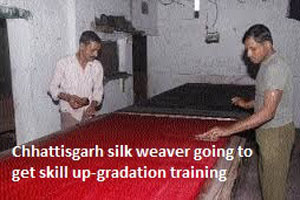
Skill upgradation training to be provided to silk weavers of Chattigarh
YarnsandFibers News Bureau 2016-06-17 17:00:00 – RaipurThe Department of Rural Industries, Government of Chhattisgarh, is going to provide skill up-gradation training to silk weavers at four block handloom silk clusters- Baloda, Navagarh, Dabra and Babnidih in Janjgir-Champa district, to promote handloom silk industry, said Deputy Director of Directorate of Rural Industries Chhattisgarh A Ayaz.
The Ministry of Textiles, Government of India has sanctioned six handloom clusters for the state.
Tussar silk is produced at Bastar, Surguja, Korba and other parts of the state. Cocoon is grown on sal, saja and arjuna trees. Tribal people collect cocoon from these trees and later they sell in local markets.
Tussar fabric weavers procure cocoon from local markets. Cocoon is boiled and silk fibre is produced. Raigarh and Janjgir-Champa are two major districts of tussar fabric production.
Champa, Baloda, Shakti, Chandrapur, Seoni, Kurda, Amoda, Choriya and Birra in Janjgir-Champa district are dense silk weaver pockets while Raigarh city, Murra, Sarangarh, Loying, Kabirnagar and Tarpali are dense silk weaver pockets in Raigarh district.
Home furnishing, dress materials, dupatta, shawl and other items are major production at Champa while Raigarh town, Chandrapur and Sarangarh are major tussar silk sari production centres.
Around 350 metric tonne silk yarn is prepared every year in Chhattisgarh. Around 60 crore direct or indirect export is done through tussar silk and around 53 lakh metre kosa silk is prepared every year in the state. Thousands of rural people depend on handloom industry.
Indian Institute of Handloom Technology has been set up at Champa in 2006 where skill manpower is prepared for Chhattisgarh handloom industry.
Market Intelligence
Ask for free sample Report

experience
Customer Base
dedicated team
Countries Served Worldwide









